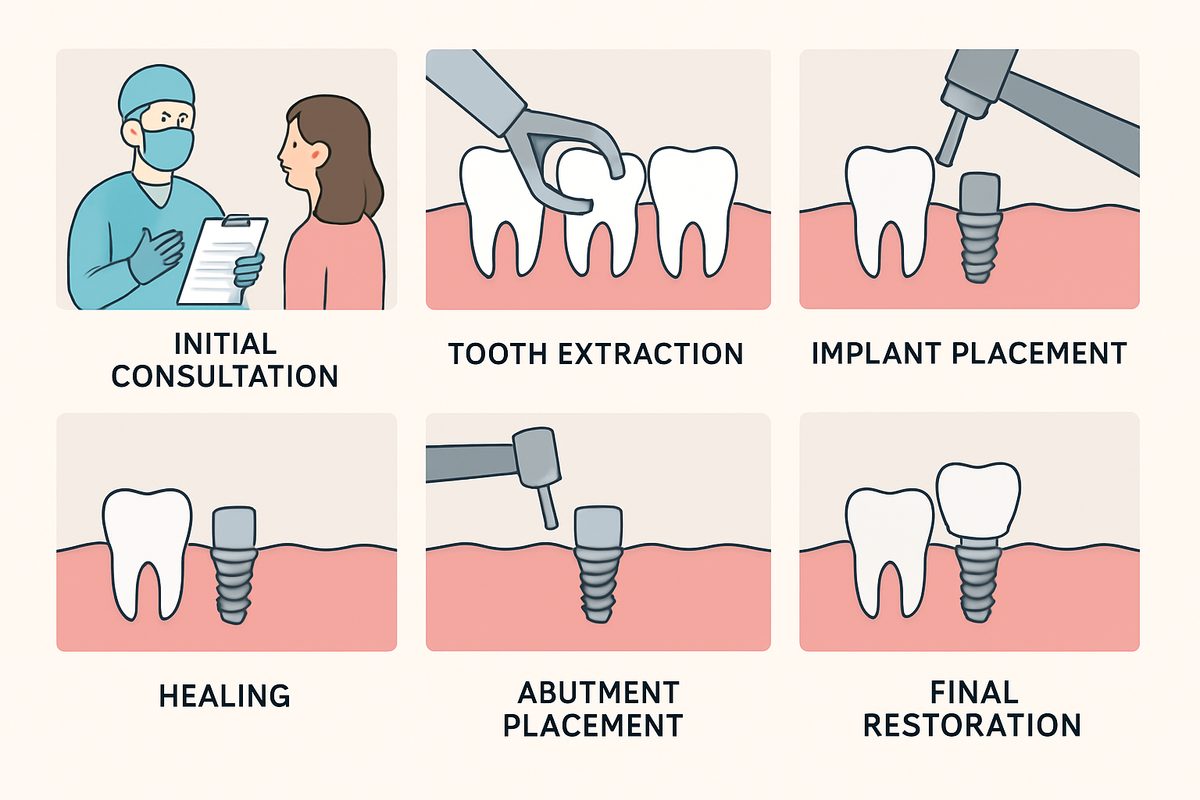If you’re wondering what “implant stages” means and whether dental implants are right for you, this guide explains the full process in clear, patient-focused language. You’ll learn the typical timeline, who makes a good candidate, common risks, and practical next steps. We’ll walk through each implant stage, so you can understand planning, surgery, healing, and final restoration — including what to expect for implant stages in Edmond, OK if you choose local care.
Understanding the implant stages: an overview
“Implant stages” refers to the step-by-step process of replacing missing teeth with dental implants. The main stages are planning, surgical placement, healing (osseointegration), and final restoration. Knowing these stages helps set realistic expectations for time, cost, and recovery. You’ll also see common terms like abutment, grafting, and prosthetic that come up during later implant stages.
Stage 1 — Consultation & treatment planning
The first implant stage begins with a comprehensive exam. Your dentist reviews medical history, takes X-rays or a CBCT scan, and may do digital impressions. This visit identifies bone levels, gum health, and any conditions that affect timing. A clear, customized plan outlines the number of implants, the need for grafting, and an estimated timeline for the remaining implant stages.
Stage 2 — Preparatory care: extractions, bone grafts, and gum treatment
Not everyone moves straight to implant placement. This implant stage includes extractions, bone grafting, or periodontal treatment when needed. These procedures restore a healthy foundation but add healing time. Your treatment plan will show where these preparatory steps fit into the overall implant stages so you know when the next surgery can occur.
Stage 3 — Implant placement surgery
On the day of surgery, you’ll review anesthesia options — from local numbing to IV sedation for anxious patients. The dentist places the titanium implant post into the jawbone. Expect minor swelling and discomfort afterward. This is a major implant stage, but it’s not the final step; the visible tooth is replaced later after healing.
Stage 4 — Osseointegration and healing
Osseointegration is when bone grows around the implant, locking it in place. This healing stage usually takes several weeks to a few months depending on location and health. Normal healing includes mild soreness and gradual reduction of swelling. Watch for signs of trouble — increasing pain, fever, or persistent drainage — and contact your dentist if they occur.
Stage 5 — Abutment, temporary restorations, and soft-tissue shaping
After osseointegration, an abutment connects the implant to the restoration. Many patients receive a temporary crown or bridge while gums shape around the new implant. These steps in the implant stages help create a natural-looking gum line and test function before the final prosthetic is made.
Stage 6 — Final restoration: crowns, bridges, or All-on-X prosthetics
The final implant stage is placing the permanent restoration. Your dentist will use impressions or digital scans (CEREC same-day when available) to craft zirconia or porcelain crowns, bridges, or full-arch All-on-X prosthetics. Once fitted, the restoration should look, feel, and function like natural teeth.
Typical timeline and what affects it
Timelines vary by case. A single-tooth implant often completes in 3–6 months. Full-arch cases with grafting or staged extractions can take 6–12+ months. Factors that lengthen or shorten implant stages include the need for bone grafts, smoking, uncontrolled gum disease, systemic health, and oral infections. For many patients, discussing a timeline for implant stages in Edmond, OK gives a realistic plan tailored to their needs.
Who is a good candidate? Key medical and dental factors
Good candidates are in generally good health, have controlled gum disease, and enough bone volume (or willingness to graft). Smoking and certain medical conditions can affect healing. Age alone is not a strict barrier. A professional exam is the only way to confirm candidacy and outline which implant stages will apply to your case.
Risks, recovery tips, and long-term care after completing implant stages
Common complications include infection, implant failure, and minor nerve or sinus issues. Immediate recovery tips include rest, ice for swelling, soft foods, and following prescribed medications. For long-term care, practice good oral hygiene, avoid tobacco, and attend regular dental check-ups to protect your investment after the implant stages are complete.
- Ice and rest first 48 hours
- Soft foods for several days
- Salt rinses after 24 hours, unless contraindicated
- Keep follow-up appointments to monitor each implant stage
Cost, insurance, and financing basics across the implant stages
Each implant stage has separate costs — planning scans, grafting, surgery, and final prosthetics add up. Most dental insurance has limits for implants; many patients use dental discount plans or third-party financing to spread costs. Your treatment plan should list fees per stage so you can budget for the full course of implant stages in Edmond, OK.
Why choose Restoration Dental for implant stages in Edmond, OK
Restoration Dental’s two-doctor team offers focused implant care, IV sedation for anxious patients, and modern options like All-on-X full-arch solutions and on-site CEREC same-day crowns. The practice emphasizes comfort, transparent planning, and technology-driven treatment that maps each implant stage clearly for patients in Edmond, OK and the surrounding area.
Next steps: is this the right time to learn about your implant stages?
If you’re ready to learn how implant stages apply to your smile, schedule a consultation to get a personalized plan and timeline. A focused exam and digital scans will clarify candidacy, expected stages, and cost so you can move forward with confidence.


